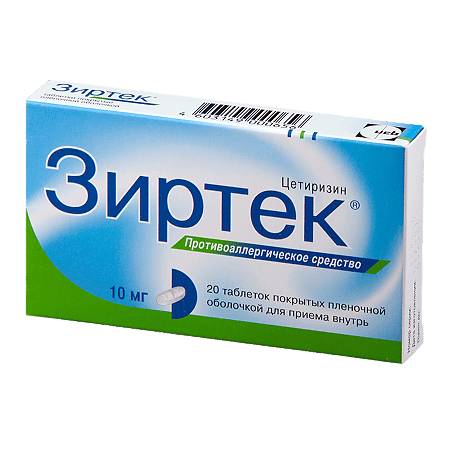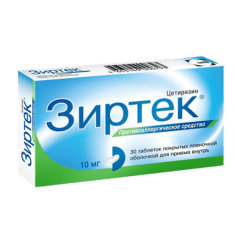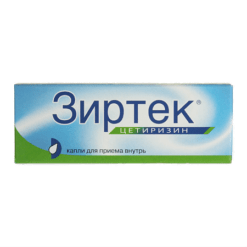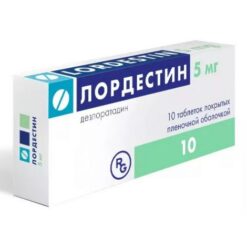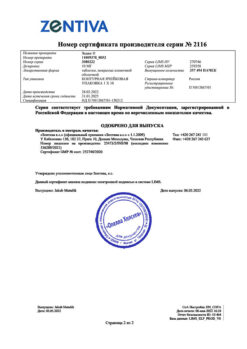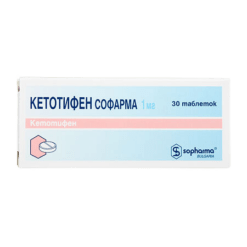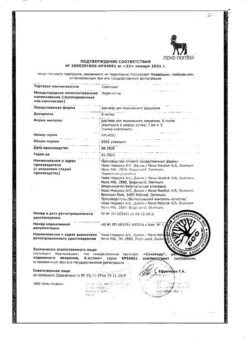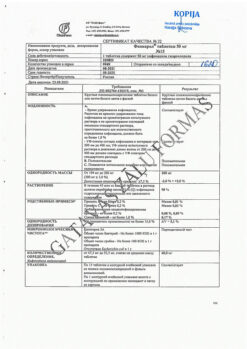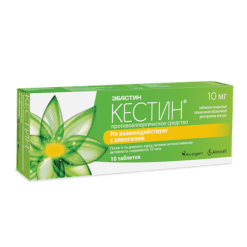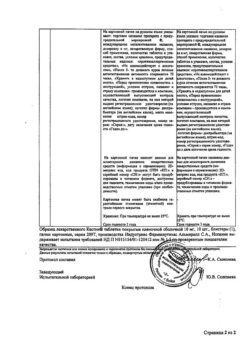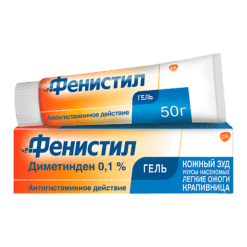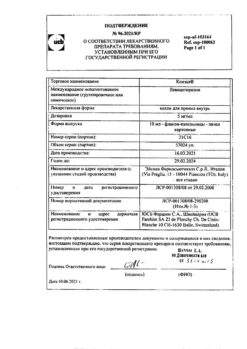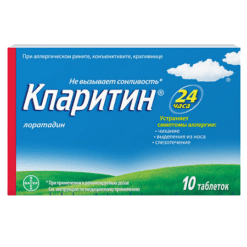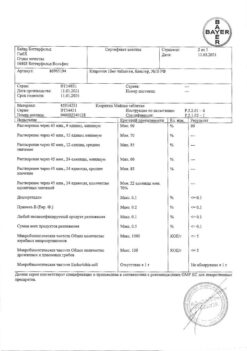No products in the cart.
Description
Pharmacological action – anti-allergic, antihistamine.
Pharmacodynamics
Cetirizine – the active ingredient of the drug Zyrtec® is a metabolite of hydroxyzine, belongs to the group of competitive histamine antagonists and blocks H1-histamine receptors.
Cetirizine prevents the development and facilitates the course of allergic reactions, has antipruritic and antiexudative actions. Cetirizine affects the early histamine-dependent stage of allergic reactions, limits the release of inflammatory mediators at the later stage of the allergic reaction, and also reduces migration of eosinophils, neutrophils and basophils and stabilizes mast cell membranes. It reduces capillary permeability, prevents the development of tissue edema, relieves smooth muscle spasm. Eliminates the skin reaction to the introduction of histamine, specific allergens, as well as cooling (in cold urticaria). Reduces histamine-induced bronchoconstriction in mild bronchial asthma.
Cetirizine has no anticholinergic and antiserotonin effects. In therapeutic doses the drug practically does not cause a sedative effect. After a single dose of 10 mg of cetirizine it causes the action in 20 minutes (in 50% of patients), in 60 minutes (in 95% of patients) and lasts more than 24 hours. During a course of treatment, tolerance to the antihistamine effect of cetirizine does not develop. After discontinuation of therapy the effect lasts up to 3 days.
Pharmacokinetics
The pharmacokinetic parameters of cetirizine change linearly.
Intake. After oral administration the drug is quickly and completely absorbed from the gastrointestinal tract. Food intake does not affect the completeness of absorption, although its speed decreases. In adults after a single use of the drug in a therapeutic dose Cmax in plasma is 300 ng/ml and is reached in (1±0.5) hours.
Distribution. Cetirizine is (93±0.3)% bound to plasma proteins. Vd is 0.5 l/kg. No cetirizine cumulation is observed when taking the drug in a dose of 10 mg for 10 days.
Metabolism. In small amounts, it is metabolized in the body by O-dealkylation (unlike other H1-histamine receptor antagonists, which are metabolized in the liver via the cytochrome system) to form a pharmacologically inactive metabolite.
Elimination. In adults, T1/2 is approximately 10 h; in children from 6 to 12 years, 6 h; from 2 to 6 years, 5 h; from 6 months to 2 years, 3.1 h. About 2/3 of the taken dose of the drug is excreted unchanged by the kidneys.
In elderly patients and patients with chronic liver disease in single use of the preparation in dose of 10 mg T1/2 is increased approximately by 50%, and systemic clearance is decreased by 40%.
In patients with mild renal impairment (creatinine Cl >40 ml/min), the pharmacokinetic parameters are similar to those in patients with normal renal function.
In patients with moderate renal insufficiency and in patients on hemodialysis (creatinine Cl<7 ml/min), when administered orally in dose 10 mg, T1/2 is prolonged by 3 times and total clearance is decreased by 70% compared to these parameters in patients with normal renal function, which requires appropriate change of dosing regimen.
Cetirizine is almost not eliminated from the body by hemodialysis.
Indications
Indications
Treatment of symptoms of year-round and seasonal allergic rhinitis and allergic conjunctivitis, such as itching, sneezing, rhinorrhea, lacrimation, conjunctival hyperemia;
hay fever (hay fever);
urticaria (including chronic idiopathic urticaria);
Quincke’s edema;
other allergic dermatoses (including atopic dermatitis), accompanied by itching and rashes.
Pharmacological effect
Pharmacological effect
Pharmacological action – antiallergic, antihistamine.
Pharmacodynamics
Cetirizine, the active substance of Zyrtec®, is a metabolite of hydroxyzine, belongs to the group of competitive histamine antagonists and blocks H1 histamine receptors.
Cetirizine prevents the development and alleviates the course of allergic reactions, has antipruritic and antiexudative effects. Cetirizine affects the early histamine-dependent stage of allergic reactions, limits the release of inflammatory mediators at the late stage of the allergic reaction, and also reduces the migration of eosinophils, neutrophils and basophils, and stabilizes mast cell membranes. Reduces capillary permeability, prevents the development of tissue edema, relieves spasm of smooth muscles. Eliminates skin reactions to the introduction of histamine, specific allergens, as well as cooling (with cold urticaria). Reduces histamine-induced bronchoconstriction in mild bronchial asthma.
Cetirizine does not have anticholinergic and antiserotonin effects. In therapeutic doses, the drug practically does not cause a sedative effect. After taking cetirizine in a single dose of 10 mg, its effect develops after 20 minutes (in 50% of patients), after 60 minutes (in 95% of patients) and lasts more than 24 hours. During a course of treatment, tolerance to the antihistamine effect of cetirizine does not develop. After discontinuation of therapy, the effect lasts up to 3 days.
Pharmacokinetics
The pharmacokinetic parameters of cetirizine change linearly.
Suction. After oral administration, the drug is quickly and completely absorbed from the gastrointestinal tract. Eating does not affect the completeness of absorption, although its speed decreases. In adults, after a single dose of the drug in a therapeutic dose, Cmax in blood plasma is 300 ng/ml and is achieved after (1±0.5) hours.
Distribution. Cetirizine is (93±0.3)% bound to blood plasma proteins. Vd is 0.5 l/kg. When taking the drug at a dose of 10 mg for 10 days, no accumulation of cetirizine is observed.
Metabolism. In small quantities, it is metabolized in the body by O-dealkylation (unlike other H1-histamine receptor antagonists, which are metabolized in the liver using the cytochrome system) to form a pharmacologically inactive metabolite.
Excretion. In adults, T1/2 is approximately 10 hours; in children from 6 to 12 years – 6 hours, from 2 to 6 years – 5 hours, from 6 months to 2 years – 3.1 hours. Approximately 2/3 of the dose taken is excreted unchanged by the kidneys.
In elderly patients and patients with chronic liver diseases, with a single dose of 10 mg, T1/2 increases by approximately 50%, and systemic clearance decreases by 40%.
In patients with mild renal failure (Cl creatinine >40 ml/min), pharmacokinetic parameters are similar to those in patients with normal renal function.
In patients with moderate renal failure and in patients on hemodialysis (Cl creatinine < 7 ml/min), when taking the drug orally at a dose of 10 mg, T1/2 is extended by 3 times, and the total clearance is reduced by 70% relative to these indicators in patients with normal renal function, which requires a corresponding change in the dosage regimen.
Cetirizine is practically not removed from the body during hemodialysis.
Special instructions
Special instructions
For children aged 6 months to 6 years, Zyrtec is prescribed in the dosage form of oral drops of 10 mg/ml.
Impact on the ability to drive vehicles and operate machinery
An objective assessment of the ability to drive vehicles and operate machinery did not reliably reveal any adverse reactions when taking the drug at the recommended dose. But, nevertheless, during the period of taking the drug, it is advisable to refrain from engaging in potentially hazardous activities that require increased concentration and speed of psychomotor reactions.
For impaired renal function
The drug should be prescribed with caution in chronic renal failure (moderate or severe), as well as in elderly patients (due to a possible decrease in glomerular filtration).
In case of renal failure, the dose is reduced depending on the QC.
Contraindicated in end-stage renal failure (CC < 10 ml/min).
Use in old age
The drug should be prescribed with caution to elderly patients (due to a possible decrease in glomerular filtration).
Use in childhood
Contraindicated in children under 6 years of age (for tablets), in children under 6 months of age (for drops).
Active ingredient
Active ingredient
Cetirizine
Composition
Composition
Active substance:
cetirizine dihydrochloride 10 mg.
Excipients:
microcrystalline cellulose,
lactose monohydrate,
colloidal silicon dioxide,
magnesium stearate;
Opadry Y-1-7000 (hypromellose (E464),
titanium dioxide (E171),
macrogol 400).
Contraindications
Contraindications
End-stage renal failure (CC < 10 ml/min);
pregnancy;
lactation period (breastfeeding);
hereditary galactose intolerance, lactase deficiency or glucose-galactose malabsorption syndrome;
children under 6 years of age (for tablets);
children up to 6 months (for drops);
hypersensitivity to the components of the drug;
hypersensitivity to hydroxyzine.
The drug should be prescribed with caution in case of chronic renal failure (correction of the dosage regimen is required), chronic liver diseases, and elderly patients (due to a possible decrease in glomerular filtration).
Side Effects
Side Effects
From the hematopoietic system: thrombocytopenia.
From the nervous system: drowsiness, dizziness, headache, aggression, agitation, confusion, depression, hallucinations, insomnia, tic, convulsions, dyskinesia, dystonia, paresthesia, fainting, tremor.
From the organ of vision: impaired accommodation, blurred vision, nystagmus.
From the cardiovascular system: tachycardia.
From the respiratory system: rhinitis, pharyngitis.
From the digestive system: dry mouth, nausea, abdominal pain, diarrhea, impaired liver function (increased levels of transaminases, alkaline phosphatase, GGT, bilirubin).
From the urinary system: urinary disorder, enuresis.
Allergic reactions: itching, rash, urticaria, angioedema, increased sensitivity, up to the development of anaphylactic shock.
Metabolism: weight gain.
Other: fatigue, asthenia, malaise, swelling.
Side effects occur in very rare cases.
Interaction
Interaction
When studying the drug interactions of cetirizine with pseudoephedrine, cimetidine, ketoconazole, erythromycin, azithromycin, glipizide and diazepam, no clinically significant adverse interactions were identified.
When administered simultaneously with theophylline (400 mg/day), the total clearance of cetirizine is reduced by 16% (the kinetics of theophylline does not change).
When administered simultaneously with macrolides and ketoconazole, no changes were noted on the ECG.
When using the drug in therapeutic doses, no data on interaction with alcohol (at a blood alcohol concentration of 0.5 g/l) were obtained. However, the patient should refrain from drinking alcohol during drug therapy to avoid depression of the central nervous system.
Overdose
Overdose
Symptoms: when taking the drug once in a dose of over 50 mg, confusion, diarrhea, dizziness, increased fatigue, headache, malaise, mydriasis, itching, weakness, sedation, drowsiness, stupor, tachycardia, tremor, urinary retention are possible.
Treatment: immediately after taking the drug, gastric lavage should be performed or vomiting should be artificially induced. It is recommended to prescribe activated carbon and carry out symptomatic and supportive therapy.
There is no specific antidote. Hemodialysis is ineffective.
Storage conditions
Storage conditions
At a temperature not exceeding 30 °C.
Shelf life
Shelf life
5 years.
Manufacturer
Manufacturer
UCB Farma, Belgium
Additional information
| Shelf life | 5 years. |
|---|---|
| Conditions of storage | At a temperature not higher than 30 ° C. |
| Manufacturer | UCB Farma, Belgium |
| Medication form | pills |
| Brand | UCB Farma |
Other forms…
Related products
Buy Zyrtec, 10 mg 20 pcs with delivery to USA, UK, Europe and over 120 other countries.

